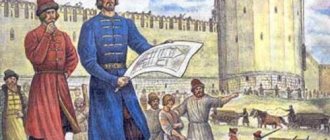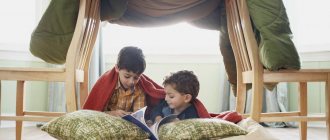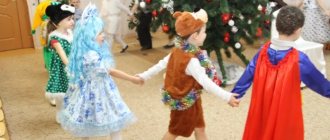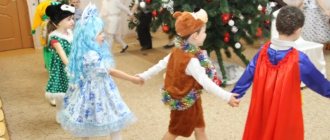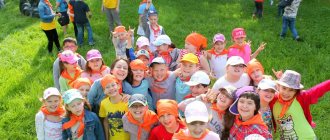According to Maria Montessori's periodization of development, the peak of activity in a variety of directions occurs in children precisely at the age of 2 to 3 years. Kids actively master speech and movement, learn to interact with a variety of objects, learn patterns and become sensitive to order, and also begin to expand their circle of acquaintances and make their first friends.
All this means that it is at this age that it is important to arrange for children all kinds of activities and games for harmonious development.
The motto of the Montessori philosophy is: “Help me do it myself.” The task of adults is to inspire children to make independent discoveries and achievements, because our little ones can do much more than it seems at first glance.
When planning Montessori activities for children 2-3 years old, you should adhere to the following rules:
- Classes should be aimed at increasing the child’s independence,
- Use different senses
- Include elements useful for the development of fine and gross motor skills,
- Take into account the interests of the child and use only at his request,
All Montessori activities should be presented to the child in advance, located in a place accessible to him (on a low shelf) and be accessible without the help of adults (however, exercises with small objects should be offered only when you have time to monitor the baby).
Games and activities to develop sensorimotor skills
What's new at this age:
- We play with clothespins (we attach clothespins to templates, transfer pieces of foam rubber using clothespins);
- Winder games;
- Making soap foam (learning to whisk, blowing bubbles through a straw);
- We find objects in the bag by touch;
- We learn to organize objects, focusing simultaneously on color and size, or color and shape;
An example of a toy suitable for this is cylinders (Labyrinth, My-shop, KoroBoom)
- We play with nuts (remember their names, sort them by type, take them out of the bag by touch);
- Playing with tweezers;
An example of baby tweezers and other useful tools for motor development
- Playing with sensory boxes;
- We play with a knocker (with nails);
Example of a knocker: Ozon, My-shop, Babadu
- We assemble the nesting doll by combining the pattern on its parts;
Example of a nesting doll: Labyrinth, My-shop, Daughters & Sons
- We assemble puzzles from 4-20 parts;
Puzzle example: Ozon, Labyrinth, My-shop
- We find the missing fragments on a homemade puzzle;
- We do finger exercises with finger toys;
Example of finger toys: Ozon, My-shop, KoroBoom
- We select bolts and nuts according to size and fasten them;
- We select the keys to the locks;
- Place pasta/buttons along the lines;
- We play with a pipette, pouring water into the cells; we play with a rubber bulb and a dispenser;
Example of a pipette
- Cut with scissors;
Example of notebooks for cutting - Kumon: Labyrinth, My-shop, Ozon
- Playing with construction sets;
Here you can find a selection of construction sets for children aged 2 years and older; and here are options for the first buildings made from cubes.
- We construct from counting sticks;
- We play with a lacing tablet;
Lacing example: Ozon, KoroBoom, My-shop
- Playing with kinetic sand;
Example of kinetic sand (Ozon, My-shop)
Already familiar games:
- We build paths from dominoes;
- Pour water from one bowl to another using a sponge;
- We make a picture using puzzle cubes;
We try options from 4 cubes: Ozon, Labyrinth, My-shop
and from 9 cubes: Ozon, Labyrinth, My-shop
- We play with two or three-layer frame inserts;
Example of three-layer and two-layer puzzles
- We play fishing with pyramid rings;
- We select lids for jars;
- We play with inset frames without background pictures;
Examples of frames: Labyrinth, My-shop, KoroBoom
- We play magnetic fishing;
Examples of fishing: Ozon, KoroBoom, My-shop
- We play mosaic;
Examples of the first mosaics: Ozon, Labyrinth, My-shop
- We open and close boxes with different closing/latching options;
- We learn to open and close locks, latches, etc.;
An example of a board with locks (My-shop, KoroBoom) or a busy board
- Pour water from the teapot into glasses;
- Sift the cereal through a strainer;
- We cut vegetables and fruits;
Example of a set of vegetables (Ozon, My-shop, Labyrinth)
- We play lotto;
- Picking mushrooms/berries;
- We dress the dolls by putting on clothes;
Examples of kits for dressing dolls (Ozon, My-shop)
- Roll the ball/ball along the slide/grooves;
An example of a bowling alley (Ozon, Labyrinth, My-shop)
- Peel the boiled egg;
- We learn to unfasten Velcro, zippers, unscrew and tighten bottle caps;
Examples of toys useful in this matter:
DIY educational mat
Book “I dress myself” (Ozone, Labyrinth, My-shop)
Board with fasteners (My-shop, KoroBoom)
Let's say a word about the necessary toys
Most educational games require certain props. These are household items, natural materials, as well as toys or sets of them. They must meet certain requirements:
- promote the development of physical skills;
- develop fine motor skills, speech, intelligence;
- reflect the child’s personal world, where he can try on a profession or social role of interest;
- develop the child’s creative potential;
- develop perseverance, diligence;
- provide an opportunity for relaxation.
It is clear that one toy will not perform all these functions. Therefore, at 2–3 years old, a child should have:
- items for physical activity (balls, gurneys, skittles, bicycles);
- sound and musical toys (drum, piano, pipe, guitar, various musical modules, “talking” books, posters, tables, talking toys and other similar toys);
- games and toys for the development of intelligence, perseverance, creativity and fine motor skills (constructors, cubes, lotto, mosaics, puzzles, nesting dolls, sorters, lacing, plasticine, pencils, paints);
- toys and sets for social and household games.
It is important to take into account that by this age children are already aware of their gender identity and develop corresponding stereotypical behavior, therefore educational sets of toys will differ depending on the gender of the child.
For girls:
- toy kitchen and utensils;
- dolls, furniture, clothes and strollers for them;
- household appliances (iron, vacuum cleaner, oven, washing machine);
- Stuffed Toys;
- "hospital" set.
For boys:
- a set of men's tools with a mini workshop;
- cars;
- pistols and machine guns;
- fortresses, soldiers;
- robots, transformers;
- transport sets (firefighter, policeman, military, ambulance);
- radio controlled toys.
Modeling
- Educational games with dough;
- Modeling from plasticine . Simple craft ideas: part 1, part 2.
Speech development
- We learn finger and gesture games;
- We do articulation exercises;
- Doing breathing exercises;
- We recite special poems together that encourage the pronunciation of sounds and words;
- Speech development games
For example:
Game "Repeat" . An adult pronounces words loudly, quietly or in a whisper. The child repeats with an appropriate level of volume.
Game “What is this for? ” An adult asks why this or that object is needed (table, chair, closet, bed). The child answers.
Game "Wrong Fairy Tale" . An adult tells some well-known fairy tale (Kolobok, for example) with errors. The child corrects, etc.
What to do with a 2-3 year old girl at home
Let's dress the doll for the holiday
First of all, talk to your child about the approaching holiday, try to evoke a joyful feeling in him. Pay attention to how everyone is preparing for the holiday, how festively the streets and houses are decorated. After a preliminary conversation, invite him to take his favorite doll (or two) and prepare elegant clothes for it, preferably several sets. Of course, you will help the baby with this.
Clothing can be as follows: two sundresses - red with buttons, yellow with ties on the side. Two dresses of different colors, trimmed with different buttons, with and without a pocket. Two blouses matching sundresses, with long and short sleeves. Bows of different colors, different widths and lengths. Let your child look carefully at these clothes, and then suggest what to wear. You help him with questions and advice. For example: “What kind of sundress should we put on the Nina doll? How does it fasten? What kind of bow should we tie?” etc. All the time, encourage your baby to notice and name the color, the details in which sundresses (and other toiletries) differ from each other. Also look at the other items, decide together what to wear for the Ole doll: choose a blouse, ribbon, etc. by color. This develops the child’s taste, sense of harmony and beauty. Here you can decide what to wear for the boy doll. When the doll is dressed for the holiday, let the baby dance with it to familiar music or sing a song.
Girl bathes a doll
What is Olya doing? What does Olya bathe her doll in? Why is there a bucket here? What's in it? What is this? (towel). Why does Ole need it? What is Olya wearing? (dress, apron). Why does she need an apron? How will you bathe your dolls? (list the sequence of actions: pour water, soap, rinse, wipe).
Girl puts doll to sleep
After showing the picture, ask the child: “What is the girl Olya going to do with the doll Mashenka after bathing? (Put to sleep). Where will Olya put Mashenka to sleep? (To the crib). Show me where the crib is? What's on it? (Pillow, sheet, blanket). Where is Mashenka sitting? (On the chair). Does Olya love her doll?” For any answer, help your child draw a conclusion: “Yes, she looks affectionately at Mashenka, and Mashenka reaches out to her. This is the song Olya sings to her dolls.” Bye-bye, bye-bye... You, little dog, don’t bark. You, little dog, don’t bark, don’t scare my Masha!
Girl combing her doll's hair
What is the girl doing? (Brushes his doll's hair.) What does the girl use to comb her doll's hair? Show two dolls: Tanya (haircut) and Katya (with braids). Ask: “Who, Katya or Tanya, will you sing this song to?” (a nursery rhyme). Grow, braid, to the waist, Don't lose a hair. Grow up, braid, don’t get confused, - Mom, daughter, listen. Such small conversations are very important for the development of a child’s speech, for generalizing and clarifying the experience accumulated in everyday life.
Reading books
Collections of books for reading to children 2 years old can be found here:
- TALES AND POEMS OF RUSSIAN AUTHORS
- TALES AND POEMS OF FOREIGN AUTHORS
- DEVELOPMENTAL BOOKS
- WINTER AND NEW YEAR BOOKS
First lessons
- We learn to count - we play the first mathematical games;
- We study geometric shapes;
- Learning colors;
- Playing with words and letters;
- We teach who lives in which house (a squirrel - in a hollow, a dog - in a booth, a mouse - in a hole, etc.);
- We teach who eats what (monkey - bananas, hare - carrots, mouse - cheese, etc.)
- Getting to know the seasons;
- We learn to classify objects into groups (clothing, dishes, transport, furniture, etc.), find what is superfluous in a group of objects;
- Remember the names of the fingers;
- We look through Doman’s cards (we study simple facts using them) or other didactic material that expands the child’s horizons;
Fun games and competitions for birthdays
Valentina Pilipenko
Fun games and competitions for birthdays
It is necessary to amuse the kids at a birthday party , otherwise they may get bored. But remember that all competitions must be , first of all, absolutely safe. Well, and, of course, there shouldn’t be any ambiguous hints, as in adult scenarios. Here are some great fun and harmless options. Here are some games that you can play at a birthday party at home or in your apartment . Organizing them does not require much effort and does not require much space. You can play them in the yard, at home or in your apartment.
Chamomile
Make a chamomile out of paper in advance - as many petals as there will be children. Write funny tasks on the back of each petal. Children tear off the petals and begin to perform tasks: walk single file, crow, jump on one leg, sing a song, repeat a tongue twister, etc.
Ball
The presenter throws up a balloon. While it is flying, you can move; if it touches the floor, everyone must freeze and not smile. Those who do not comply are eliminated from the game .
Rope
Two participants sit on chairs with their backs to each other. There is a rope or cord under the chairs. At the leader’s signal, each player runs around the other’s chair, sits on his own chair and tries to quickly grab the end of the rope and pull it out.
Shore and river
This game requires children to be attentive. Two lines are drawn on the ground at a distance of about 1 m. Between these lines there is a river, and along the edges there is a shore. All the guys stand on the banks. The leader gives the command: “river”
, and all the guys jump into the river.
At the command “shore”
everyone jumps ashore.
The leader gives commands quickly and randomly to confuse the players. For example: “Bank, river, river, bank, river, river, river.”
If at the command
“bank”
someone ends up in
the “river”
(and vice versa), then he leaves
the game . The game continues until the most attentive participant is determined. He is rewarded and the game starts again.
Colored miracles
Children are given sheets of white paper on which an invisible drawing is made with a paraffin candle. They paint them with different watercolor colors. A drawing that was drawn with paraffin will appear on a colored background.
Guess who am I!
Those who wish are blindfolded and allowed to try small pieces of either sausage, or cheese, or boiled vegetables, or a little bit of some salads. Participants determine products.
Artist competition
On a large sheet of whatman paper we suggest drawing a general drawing or coloring an already drawn drawing. This collective picture is presented to the birthday boy on behalf of all wizards.
Mummy
Participants are divided into pairs, each pair receives a roll of toilet paper, and one wraps the other in paper from head to toe, competing to see which pair can finish the fastest.
Favorite color
The game is very simple, but exciting and fun . The presenter names a color. Children must find this color in clothes or in the things of their comrades and take on it. The one who does not have time is eliminated or becomes the leader.
Chain
A game that you can play without leaving your workplace. And during the holiday, have more ordinary paper clips in stock. Invite the children to make a chain from paper clips in 1–2 minutes. The one whose chain is longer will win.
Hiding the candy
A simple and exciting competition . Invite the kids to treat the adults with the collected candies. Ask everyone to leave the room and hide 10-20 pieces of candy. Hiding doesn't have to be far and deep. Place them in visible but unexpected places. Call the children into the room and offer to collect all the candy. The one who finds the most candies wins.
Who hurt it?
One child is blindfolded and turned with his back to the others. Someone lightly touches him with their hand, you have to guess who it is? If he guessed correctly, the person who touched him is blindfolded and becomes a “guesser.”
Crosses
Required: checkered pieces of paper, pens or pencils.
All children receive leaves and pens.
Task: Draw a lot of crosses in a minute
Winner: The one who draws the most crosses.
Fruits on a string
Needed: rope, thread, fruit, blindfolds, scissors.
Stretch the rope by securing it on both sides to something, such as handles on cabinets. Tie a string to each fruit and hang the fruits on the string. Blindfold your child. He must reach the rope, cut any fruit with scissors and guess it by touch.
Scarecrow
Musical accompaniment sounds. Children, each of whom is a “scarecrow,” go out to the middle of the room and spread their arms to the sides. If the leader says: “Sparrow!”
, then you need to wave your arms. If the presenter says:
“Crow!”
- You have to clap your hands.
Tie a scarf
Required: three chairs, three scarves or scarves.
Two or three boys compete. In front of each boy, a girl sits on a chair; headscarves hang on the backs of the chairs. At the signal, the boys tie scarves on the girls.
Winner of the competition : the boy who can tie a scarf the fastest.
Tender words
Required: balloon - 2-3 pieces.
Children invite their parents and everyone stands in a circle. The presenter says a gentle word about mom and passes the balloon to the person standing next to her. He says a gentle word and passes the ball on. Whoever does not say the word leaves the game .
The remaining 2-3 people win and are awarded balls.
Pass the parcel
You need to: prepare the package - take a candy or small toy and wrap it in many pieces of paper or newspaper (you can use adhesive tape, but not too much, otherwise it will be difficult for children to unwrap).
The children sit in a circle and the leader says: “We received a package, but I don’t know who it’s for. Let's find out! "
Children begin to pass the parcel to each other in a circle, unfolding one piece of paper at a time.
Whoever unwraps it last gets the package.
This game teaches children to share.
Information prepared by: V. V. Pilipenko,
musical director.
Logic games
For example:
- We play with Dienesh's logic blocks;
- We lay out simple patterns;
- We assemble simple patterns from Nikitin’s cubes “Fold the pattern”
and etc.
More logic games can be found in the article “Logic games for children 2-3 years old”
Role-playing games
Ideas for simple story games can be found here and here. From about 2 years old, a child becomes interested not only in watching the scenes that you show him, but also in participating in them himself. Therefore, invite your child to take on some role during the game. Act out simple fairy tales (turnip, bun, hen, etc.).
Montessori classes to develop a sense of order for children 2-3 years old
Such exercises help the child understand the principles by which our world exists; mainly here we work on sorting and classification.
Find a pair - Montessori classes for 2-3 years old
The principle of pair selection can be very widely used in working with children:
- Invite your child to sort his own socks and gloves.
- Print out images of animals and offer to compare the picture with existing toy models (the same can be done with your favorite cars, flowers, building models, etc.)
- Offer to find paired cards (colors, images, textures),
- Use special Montessori materials for 2 years and older
Sorting – complicated Montessori games for children from 2 years old
When the baby has mastered pairs, you can move on to a more complex option - sorting.
- Sort cards of different shades by color (you can cut pictures from magazines, scraps, colored cardboard, or you can buy a ready-made Montessori set),
- Remember Cinderella and offer to sort out different types of cereals. First, it is better to take larger grains: beans, chickpeas. Children's breakfast cereals with their cereals, pillows and rings can also be convenient,
- Sort out the box with grandma's buttons by shape, color or number of holes (you definitely have one!)
- Ask your child to put the cutlery in its place,
- Offer to clean up the kitchen and put all the cylinders and balls in one direction, and the cubes and parallelepipeds in the other,
- Rewind the salad: cucumbers to cucumbers, tomatoes to tomatoes, and so on
Establishing Montessori Sequences for a Child 3 Years and Under
- Lay out cards with simple stories and ask your child to remember the correct sequence of events.
- Use Montessori cylinders to help your child master the concepts of less-more and lower-higher,
- Learn simple self-care steps, breaking them down into steps. This way you can learn how to brush your teeth, take a shower, care for animals, and get ready for kindergarten.
Music classes
- Listening to classical music;
- We play simple outdoor musical games;
Physical activity
- We walk on a massage mat (Ozone, My-shop);
- We learn to walk along a line or footprints taped to the floor;
- We learn to jump up, trying to touch an object located just above outstretched arms;
- We learn to jump over a rope or obstacle 10-20 cm wide.
- Learning to stand on one leg;
- Learning to walk on tiptoes;
- We throw small balls or pebbles with one hand into the distance, throw the ball with both hands from behind the head;
- We throw balls at a horizontal target (for example, a basket standing on the floor);
- We get used to doing exercises in the morning;
- We learn to act on a signal. For example, the following motor games will be useful:
Game "Traffic Light" . The adult says “Green” (or shows a green card) - the child walks or pretends to be driving a car. The adult says “Red” (shows the red card) - the child stands.
Game "Planes" . On command, we start the engines (rotate our arms in front of our chests, say “rrrr”), take off (arms to the sides), go for landing (slowly stop, lower our arms).
Game "Day-Night" . When an adult says “day”, the child runs, when “night” he freezes and “sleeps”.
Games for children 2-3 years old card index (junior group) on the topic
Card index of games for children 2-3 years old
“Good morning!” Goal: to help children adapt to the conditions of kindergarten. Objectives: - creating a positive emotional climate in the group; - relieving emotional stress. Progress of the game: An adult, together with the children, sings the text: - Good morning, eyes! (touch the eyes with our fingertips). You woke up? (claps hands). - Good morning, nose! (touch the tip of the nose). Are you awake? (claps hands). - Good morning, ears! (touch both ears with your fingertips). You woke up? (claps hands). - Good morning, little mouth! (touch lips with index finger). Are you awake? (claps hands). - Good morning, hands! (we use both hands to make “flashlights”). You woke up? (claps hands). - Good morning, tummy! (circular stroking of the palm on the tummy). Are you awake? (claps hands). - Good morning, kids! Is everyone awake? Let's reach for the sun! (hands up, stretch).
“Round dance” Goal: to help children adapt to the conditions of kindergarten. Objectives: - creating a positive emotional climate in the group; - relieving emotional stress. - development of a sense of rhythm and coordination of movements. Progress of the game: The teacher holds the child (children) by the hands and walks in a circle, saying: Around the rose bushes, Among the grass and flowers, We circle, circle the round dance. We were so dizzy that we fell to the ground. Bang! When the last phrase is said, everyone “falls” to the ground. Game option: Around the rose bushes, Among the grass and flowers, We dance, we dance. As we finish the circle, we suddenly jump together. Hey! An adult and a child jump up and down together.
“Jump More Fun” Goal: to help children adapt to the conditions of kindergarten. Objectives: - creating a positive emotional climate in the group; - relieving emotional stress; - development of a sense of rhythm, coordination of movements. Progress of the game: The teacher tells a nursery rhyme and shows the movements. The children repeat after him. Jump, jump more fun! Jump on two legs Jump, jump - quickly! Up, down, up, down! Raise your arms up, down and spin a little! They spin around in place. We'll rest a little and start playing again. The game is repeated several times.
“Sunny Bunnies” Goal: to help children adapt to the conditions of kindergarten. Objectives: - creating a positive emotional climate in the group; - relieving emotional stress; - development of a sense of rhythm and coordination of movements. Material: Small mirror. Progress of the game: The teacher releases sunbeams with a mirror and says: Sunbeams are playing on the wall. Lure them with your finger, let them run to you! At the signal “Catch the bunny!” the children are trying to catch him. The game can be repeated 2-3 times.
“Autumn Leaves” Goal: to help children adapt to the conditions of kindergarten. Objectives: - creating a positive emotional climate in the group; - relieving emotional stress; - development of a sense of rhythm, coordination of movements; - Encourage children to interact with each other. Materials: Gnome toy, autumn leaves made of cardboard of different colors, tape recorder, audio recording of slow music. Progress of the game: The teacher tells the children that today a little gnome came to the children and brought beautiful leaves. - Let's tell you what color the leaves are. — The gnome invites you to dance with the leaves. Children take leaves and spin with them to the music. - Do you want to dance with the gnome? The teacher, holding the gnome in his hands, takes one child by the hands and spins with him in pairs. So the gnome “dances” with all the children in turn. Then the gnome is placed in the center, the children give him leaves, stand in a round dance and walk around the gnome to the music. In conclusion, the gnome thanks the kids.
“Playing with a dog” Goal: to help children adapt to the conditions of kindergarten. Objectives: - creating a positive emotional climate in the group; - relieving emotional stress; - development of a sense of rhythm, coordination of movements; - Encourage children to interact with each other. Material: toy dog. Progress of the game: The teacher holds the dog in his hands and says: Woof-woof! Who's there? This is a dog visiting us, I put the dog on the floor. Give Petya a paw, little dog! Then he approaches the child, whose name is named, with the dog and offers to take it by the paw and feed it. Brings a bowl of imaginary food, the dog “eats soup”, “barks”, says “thank you” to the child! When repeating the game, the teacher calls the name of another child.
“Ladushki - firecrackers” Goal: to help children adapt to the conditions of kindergarten. Objectives: - create a positive emotional climate in the group; - relieving emotional stress; - development of a sense of rhythm, coordination of movements. Progress of the game: An adult recites a poem, performing the actions: Palms, palms, loud crackers, clapping our hands, clapping a little. Yes! (clap our hands loudly). - They cooked the porridge and stirred it with a spoon. (the adult helps the child move the finger of his right hand along the palm of his left). — The doll was fed. Yes! - They gave it to the cat. Yes! (extend the left palm forward). - They put their fists together, they beat with their fists, knock, knock, knock, knock, knock, knock, knock, knock, knock, knock. Yes! (clench your fingers into fists and resolutely tap them together). - The palms danced, The children were amused, La-la-la, la-la-la, La-la-la, la-la-la. Yes! (we make lanterns). - Ladushki are tired, Ladushki are asleep, Bye-bye, bayushki, Bye-bye, okay. Yes! (fold the palms of our hands and place them on our cheeks).
“Bunny” Goal: to help children adapt to the conditions of kindergarten. Objectives: - creating a positive emotional climate in the group; - relieving emotional stress; - Encourage children to interact with each other.
How to play: Children, holding hands, walk together in a circle. The teacher sings a song: Bunny, bunny, what's wrong with you? You're sitting there completely sick. Don't you want to play, dance with us? Bunny, bunny, dance and find another one. After these words, the children stop and clap their hands. “Bunny” gets up and chooses a child, calling him by name, and he himself stands in a circle. The game repeats itself.
“Blowing Soap Bubbles” Goal: to help children adapt to the conditions of kindergarten. Objectives: - creating a positive emotional climate in the group; - relieving emotional stress. Material: soap bubbles. Game progress: The teacher blows soap bubbles and says: - Be careful, bubbles! - Oh, what! - Look! - They're swelling! - They shine! - They're having a blast! - They're flying! - Here - from the plum! - That's as big as a nut! - It didn’t burst for the longest time! Children catch soap bubbles.
“Train” Purpose: to help children adapt to the conditions of kindergarten. Objectives: - creating a positive emotional climate in the group; - relieving emotional stress; - Encourage children to interact with each other. - practicing basic movements - running, walking. Progress of the game: The teacher suggests playing “train”: “I am the locomotive, and you are the carriages.” Children stand in a column one after another, holding onto the clothes of the person in front. “Let’s go,” says the adult, and everyone begins to move, saying: “Choo-chu-chu.” The teacher drives the train in one direction, then in the other, then slows down, stops and says: “Stop.” After some time, the train sets off again.
“Cucumber-cucumber” Goal: to help children adapt to the conditions of kindergarten. Objectives: - creating a positive emotional climate in the group; - relieving emotional stress. Progress of the game: At one end of the playground there is a teacher, at the other there are children. They approach the leader by jumping on two legs. The teacher says: Cucumber, cucumber, don’t go to that end, the mouse lives there, it will bite off your tail. At the last words, the children run away, and the teacher catches up with them. The game is repeated several times.
“Carousels” Goal: to help children adapt to the conditions of kindergarten. Objectives: - creating a positive emotional climate in the group; - relieving emotional stress; - interaction between children. Progress of the game: Holding hands, the children together with the teacher move in a circle, saying: Barely, barely, barely, the carousel is spinning (the carousel is slowly moving to the right). And then, then, then Everyone runs, runs, runs (the pace of speech and movements gradually accelerates)! Let's run, let's run, Let's run, let's run (everyone is running)! Hush, hush, don’t rush, Carousel os-ta-no-vi-te. One-two, one-two (pause), So the game is over (the pace of movements gradually slows down, at the words one-two, everyone stops and bows to each other). Repeat the game 3-4 times, each time changing the direction of movement.
“In our group” Goal: to help children adapt to the conditions of kindergarten. Objectives: - creating a positive emotional climate in the group; - relieving emotional stress; - introducing children to each other. Progress of the game: The teacher invites the children to sit in a circle, clap their hands, saying: In our group, in our group, There are many little children, Many little children, They sit together side by side. We name all the children in turn: And we have... Nastya And we have... Petya, etc. A lot of little guys, A lot of little guys sitting side by side together. The game is repeated several times so that the children remember each other.
“Zainka is a good girl” Goal: to help children adapt to the conditions of kindergarten. Objectives: - creating a positive emotional climate in the group; - relieving emotional stress. Progress of the game: The teacher stands opposite the child and asks him to repeat the movements of the bunny: Shall we be a bunny? Come on, little bunny, bow, little gray one, bow. That's it, that's it, bow down. (bow in different directions) Zainka, turn around, little gray one, turn around. That's it, that's it, turn around. (turn around, hands on the belt) Bunny, stomp your foot, little gray stomp your foot. Like this, like this, stomp your foot, little gray stomp and stomp your foot. Like this, like this, stamp your foot. (they stomp each foot in turn) At the end of the game, the teacher praises the “bunny” and pats him on the head: “Well done!” Strokes arms and legs. The game is repeated at the child's request.
“Once upon a time there was a little goat with grandma” Goal: to help children adapt to the conditions of kindergarten. Objectives: - creating a positive emotional climate in the group; - relieving emotional stress. Progress of the game: Children stand near the teacher. The teacher says: Once upon a time there lived a goat with my grandmother. He had legs like this (children put their legs out one at a time), and hooves here (squat down and touch the heels), horns here (put their hands to the head), a tail behind his back like this (point with hand, looking back). There was a little goat (children squat), then he grew up and became big, like this (they stand up and rise on their toes). The goat's horns were small, but then they grew big! The tail was small, but it grew big and long (show with hands). The goat wanted to take a walk, he went through the fields, through the valleys, over the high mountains (the children disperse throughout the entire area). The grandmother calls the goat home, but he says: I don’t want to! Go home, little goat, or the wolf will eat you! (The teacher portrays a wolf and invites the children to run away from it.) The game is repeated at the request of the children.

